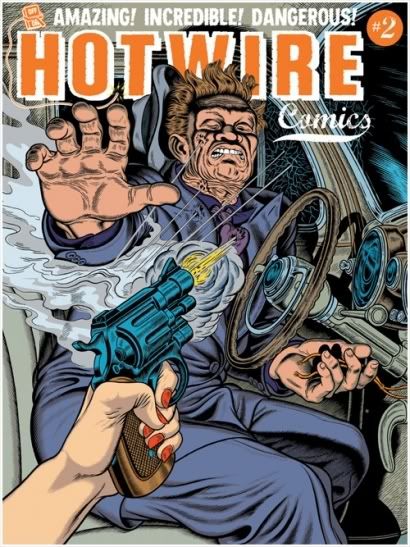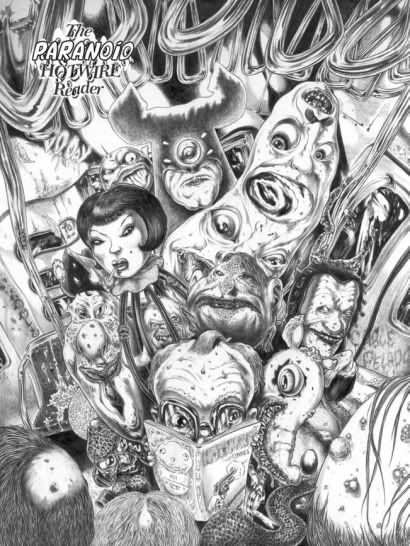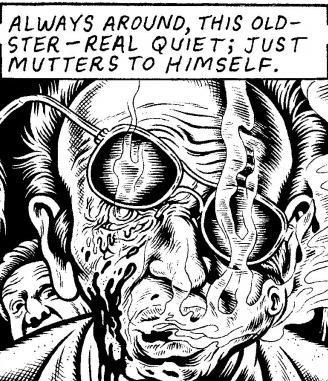Capers of a hundred flavors.
Hotwire Comics #2
This will be out soon. It's a $22.99 softcover anthology from Fantagraphics, 136 pages in b&w and color.
That doesn't quite make it a 'Fantagraphics anthology' in the manner of MOME, mind you - the latter series' editors, Gary Groth and Eric Reynolds, respectively serve as Fantagraphics' co-publisher and marketing director, thus reinforcing the position of MOME as a 'house' anthology. In contrast, Hotwire Comics -- formerly Hotwire Comix and Capers -- is edited and designed by Glenn Head, an outside party with prior connections to the publisher, most pertinently his work (with associate editor Kaz) on the 1990-93 anthology series Snake Eyes, which provided an increasingly broad, visually resplendent tour of then-current alternative comics across its three volumes.
It's a different environment now, and Hotwire is a different anthology. As Head remarked to Douglas Wolk at Publisher's Weekly in 2006: "There's a great deal of humorless, pedantic stuff; there's not that much of a kick to it. The cheap, vulgar side of comics that's disappeared - I really wanted to bring that back. That's what I was into." And Hotwire very much dresses the part - its 9" x 12" size and glossy exterior gives it the feel of a large, heavy, bathroom-ready magazine, the antithesis of the reserved, smallish, quarterly review-type MOME (or the hulking color burn of a Kramers Ergot). Then again, I don't think you need to hold anything in your hands to pick up the difference between

or even

and

All the stuff underneath that cover doesn't sit easily, though. Excluding all the humorless and pedantic stuff Head refers to above, Hotwire still has an extremely broad base of comics to choose from, and it's unwilling to settle on just a few; as a result, it's an oddly jangled, conflicted book for one with such a seemingly clear mission. It does feel a bit like an old underground anthology, one in which, say, the likes of Kim Deitch and Richard Corben might rub shoulders for the simple purpose of getting some wild comics up and and onto the page, regardless of individual approach.
But it's been 40 years since that time, and different species of alternative comics have had decades to develop on their own, without so much need to band together as a collective Other - putting this kind of anthology together today risks tonal incoherence from multiple specialized, incompatible parts. I realize I'm getting theoretical here -- many readers simply pluck out the parts they like from anthologies anyway, confident that the whole is by its nature scattershot and prone to varying quality -- but I do think that individual stories can be lifted higher by a strong arrangement among others, and that too much discordance (or sameness) can detract from isolated pieces.
Regardless, Hotwire flails amidst approaches, many of which can be sampled here, like a long-lost underground jam tumbling though a time warp, ripping loose bits and pieces of RAW and Weirdo in mid-plunge before crashing through an issue of Blab! to break its fall. It can be striking. At one point, Craig Yoe presents a homage to Tijuana Bibles in his colorful, Griffinesque freakout style, basically a visual poem or song, filled with sexually suggestive cartoon figures spurting repeated exclamations. "It's not the good duck artist!" "Don't B uptight!" "It's the good fuck artist!" "Feel so right!" Neither duck artists nor fuck artists could sign their work, of course; Yoe suggests the joinder of high and low cartooning through shared anonymity, all while a beret-wearing dude nervously stares at the action from behind, via rips in each page.
Right next to that is a page of Mark Newgarden's dour, precise anti-gag cartoons (with captions by English comic Simon Munnery), immediately followed by another one of R. Sikoryak's literary/comics mashups, this time a Little Nemo take on The Picture of Dorian Gray, cleverly exploiting Winsor McCay's fancy for panel-by-panel gradual transformation in charting the off-panel antics of lil' Dori. Then it's off to a Jonathon Rosen juxtaposition of 3/4 page wordless illustration, isolated narrative text and complimentary narrative via diagrammed sketching - it's like every recent argument against stolid art comics (no drawing chops! no storytelling! no humor!) all showing up at the same party, and it turns out that some of them would sort of like to kick each other's asses too.

I haven't even gotten into the swathes of pure illustration -- you're looking at David Paleo above, although there's also some nice Danny Hellman and Stephane Blanquet stuff too -- or the various humor bits, ranging from the aforementioned Newgarden/Munnery gags (killing humor with visual irony) to Ivan Brunetti's geometric dirty jokes (creating humor with visual contrast), to a Johnny Ryan Sin City parody featuring Frank Miller eating Mickey Spillane's shit with a spoon, and Marv breast-feeding a living pistol, muzzle to nipple. Did I mention Chris Estey's & Dave Lasky's fragmented, allusory tribute to Mick Jones of The Clash?
I'm tossing these pieces around to give you an idea of how random, even haphazard the anthology gets, in spite of its focus on lively kicks and popping eyes. That's not to say some of those parts aren't perfectly fine - I also liked Mary Fleener's effortlessly funny and appealing anecdote about being stuck in a car on unwanted drugs with a 'friend' who's prone to pulling over for dealing on the way home. I wish I'd liked Mack White's contribution more, since he's an old hand at grounded stories of rare, building verve, but all he's got is a simplistic demonstration of Old West entertainment-as-history whitewashing, complete with compare-contrast filmstrip segments.
Of the 'new' artists, the most prominent is Tim Lane, who provided the cover art and no less than three stories - Fantagraphics is planning a hardcover collection of his short pieces (Abandoned Cars) for this May. His rich, heavy style, highly reminiscent of Charles Burns is just the sort of thing you'd expect to headline a book of Hotwire's mission. It's eye-catching, lending itself well to the isolated images of a two-page dream comic, or crucial moments of dramatic or surreal impact.

But his writing is less assured, his characters' incessant narration sometimes toeing the line between plainspoken grit and possible proofreading error (one balloon and two captions in one panel - "Holy shit!" "Said Marty, and started laughing. I guess he didn't know what else to do." "Then I seen the gun on the floor as the carny split for the door."). A five-page story ambles distractedly through a character epiphany, and a seven-page opener for a serial chokes its detailed caricatures with rolling waves of stylized dialogue before settling into a steady beat - my impression from this book is that he's a talented illustrator who's got a ways to go in narrative comics, although I'd sure like to see him keep going.
His stories' vivid, hamstrung nature can be taken as a model of Hotwire the package - of visual power, but unable to collect itself into a stronger whole. Even the broadest contours of its identity become fuzzy at times; I don't know what to make of the presence of an eight-pager by the underappreciated Carol Swain, welcome as it is. Working in soft colors and expressive ink scratches, pencil details left in, Swain builds a wistful yet omnious fable of reading as sickness, and good books falling from the sky, only for their words to drift away with the wind. It's quiet, meticulous, and frankly indistinguishable in character or tenor from something that might pop up in MOME, or Chris Ware's Hott Picks 2006-07.
It's good enough to look for, though, as may be this book's other bright, isolated pulses.
This will be out soon. It's a $22.99 softcover anthology from Fantagraphics, 136 pages in b&w and color.
That doesn't quite make it a 'Fantagraphics anthology' in the manner of MOME, mind you - the latter series' editors, Gary Groth and Eric Reynolds, respectively serve as Fantagraphics' co-publisher and marketing director, thus reinforcing the position of MOME as a 'house' anthology. In contrast, Hotwire Comics -- formerly Hotwire Comix and Capers -- is edited and designed by Glenn Head, an outside party with prior connections to the publisher, most pertinently his work (with associate editor Kaz) on the 1990-93 anthology series Snake Eyes, which provided an increasingly broad, visually resplendent tour of then-current alternative comics across its three volumes.
It's a different environment now, and Hotwire is a different anthology. As Head remarked to Douglas Wolk at Publisher's Weekly in 2006: "There's a great deal of humorless, pedantic stuff; there's not that much of a kick to it. The cheap, vulgar side of comics that's disappeared - I really wanted to bring that back. That's what I was into." And Hotwire very much dresses the part - its 9" x 12" size and glossy exterior gives it the feel of a large, heavy, bathroom-ready magazine, the antithesis of the reserved, smallish, quarterly review-type MOME (or the hulking color burn of a Kramers Ergot). Then again, I don't think you need to hold anything in your hands to pick up the difference between

or even

and

All the stuff underneath that cover doesn't sit easily, though. Excluding all the humorless and pedantic stuff Head refers to above, Hotwire still has an extremely broad base of comics to choose from, and it's unwilling to settle on just a few; as a result, it's an oddly jangled, conflicted book for one with such a seemingly clear mission. It does feel a bit like an old underground anthology, one in which, say, the likes of Kim Deitch and Richard Corben might rub shoulders for the simple purpose of getting some wild comics up and and onto the page, regardless of individual approach.
But it's been 40 years since that time, and different species of alternative comics have had decades to develop on their own, without so much need to band together as a collective Other - putting this kind of anthology together today risks tonal incoherence from multiple specialized, incompatible parts. I realize I'm getting theoretical here -- many readers simply pluck out the parts they like from anthologies anyway, confident that the whole is by its nature scattershot and prone to varying quality -- but I do think that individual stories can be lifted higher by a strong arrangement among others, and that too much discordance (or sameness) can detract from isolated pieces.
Regardless, Hotwire flails amidst approaches, many of which can be sampled here, like a long-lost underground jam tumbling though a time warp, ripping loose bits and pieces of RAW and Weirdo in mid-plunge before crashing through an issue of Blab! to break its fall. It can be striking. At one point, Craig Yoe presents a homage to Tijuana Bibles in his colorful, Griffinesque freakout style, basically a visual poem or song, filled with sexually suggestive cartoon figures spurting repeated exclamations. "It's not the good duck artist!" "Don't B uptight!" "It's the good fuck artist!" "Feel so right!" Neither duck artists nor fuck artists could sign their work, of course; Yoe suggests the joinder of high and low cartooning through shared anonymity, all while a beret-wearing dude nervously stares at the action from behind, via rips in each page.
Right next to that is a page of Mark Newgarden's dour, precise anti-gag cartoons (with captions by English comic Simon Munnery), immediately followed by another one of R. Sikoryak's literary/comics mashups, this time a Little Nemo take on The Picture of Dorian Gray, cleverly exploiting Winsor McCay's fancy for panel-by-panel gradual transformation in charting the off-panel antics of lil' Dori. Then it's off to a Jonathon Rosen juxtaposition of 3/4 page wordless illustration, isolated narrative text and complimentary narrative via diagrammed sketching - it's like every recent argument against stolid art comics (no drawing chops! no storytelling! no humor!) all showing up at the same party, and it turns out that some of them would sort of like to kick each other's asses too.

I haven't even gotten into the swathes of pure illustration -- you're looking at David Paleo above, although there's also some nice Danny Hellman and Stephane Blanquet stuff too -- or the various humor bits, ranging from the aforementioned Newgarden/Munnery gags (killing humor with visual irony) to Ivan Brunetti's geometric dirty jokes (creating humor with visual contrast), to a Johnny Ryan Sin City parody featuring Frank Miller eating Mickey Spillane's shit with a spoon, and Marv breast-feeding a living pistol, muzzle to nipple. Did I mention Chris Estey's & Dave Lasky's fragmented, allusory tribute to Mick Jones of The Clash?
I'm tossing these pieces around to give you an idea of how random, even haphazard the anthology gets, in spite of its focus on lively kicks and popping eyes. That's not to say some of those parts aren't perfectly fine - I also liked Mary Fleener's effortlessly funny and appealing anecdote about being stuck in a car on unwanted drugs with a 'friend' who's prone to pulling over for dealing on the way home. I wish I'd liked Mack White's contribution more, since he's an old hand at grounded stories of rare, building verve, but all he's got is a simplistic demonstration of Old West entertainment-as-history whitewashing, complete with compare-contrast filmstrip segments.
Of the 'new' artists, the most prominent is Tim Lane, who provided the cover art and no less than three stories - Fantagraphics is planning a hardcover collection of his short pieces (Abandoned Cars) for this May. His rich, heavy style, highly reminiscent of Charles Burns is just the sort of thing you'd expect to headline a book of Hotwire's mission. It's eye-catching, lending itself well to the isolated images of a two-page dream comic, or crucial moments of dramatic or surreal impact.

But his writing is less assured, his characters' incessant narration sometimes toeing the line between plainspoken grit and possible proofreading error (one balloon and two captions in one panel - "Holy shit!" "Said Marty, and started laughing. I guess he didn't know what else to do." "Then I seen the gun on the floor as the carny split for the door."). A five-page story ambles distractedly through a character epiphany, and a seven-page opener for a serial chokes its detailed caricatures with rolling waves of stylized dialogue before settling into a steady beat - my impression from this book is that he's a talented illustrator who's got a ways to go in narrative comics, although I'd sure like to see him keep going.
His stories' vivid, hamstrung nature can be taken as a model of Hotwire the package - of visual power, but unable to collect itself into a stronger whole. Even the broadest contours of its identity become fuzzy at times; I don't know what to make of the presence of an eight-pager by the underappreciated Carol Swain, welcome as it is. Working in soft colors and expressive ink scratches, pencil details left in, Swain builds a wistful yet omnious fable of reading as sickness, and good books falling from the sky, only for their words to drift away with the wind. It's quiet, meticulous, and frankly indistinguishable in character or tenor from something that might pop up in MOME, or Chris Ware's Hott Picks 2006-07.
It's good enough to look for, though, as may be this book's other bright, isolated pulses.

<< Home